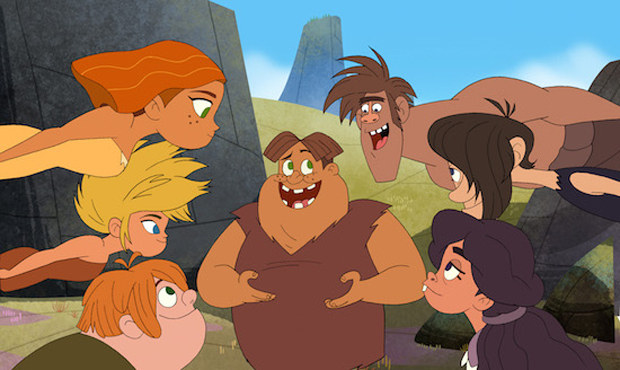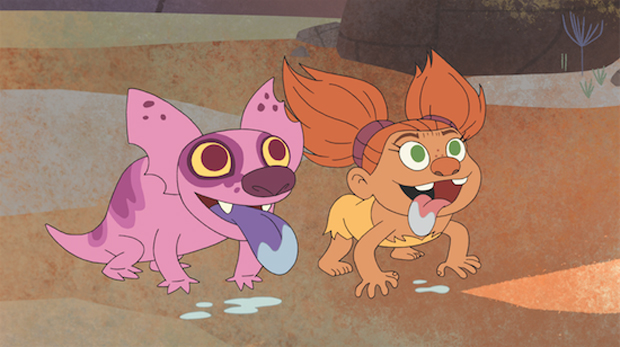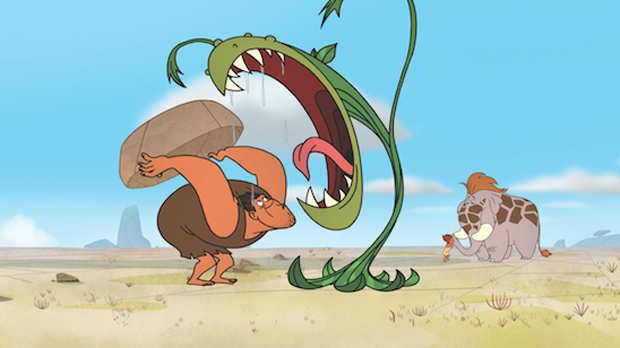One of the ways in which DreamWorks Animation Television is fulfilling its deal with Netflix is by adapting its successful features into animated series. The most recent is Dawn of The Croods, which debuted Dec. 24 its first season of 13 half-hour episodes on the streaming service.
Heading up the new series is showrunner Brendan Hay, whose credits run the gamut from headline producer for The Daily Show with Jon Stewart to Emmy-nominated writer for such animated series as Robot Chicken, The Simpsons and The Mighty B! He also was the head writer on the completed but still unseen Lucasfilm Animation series Star Wars Detours and has written graphic novels and comics for Oni Press and BOOM! Studios.

We caught up with him to get to the lowdown on the new series.
Animation Magazine: How did you get this gig?
Brendan Hay: It was one of these cases of where my agent mentioned that DreamWorks was looking to develop a series based on The Croods. The only guideline I was told going in was it had to be a prequel because they’re doing a feature sequel, and it just got me thinking. In the feature, there’s one joke in the opening — not even in the feature — it’s in one of the little prologues that Eep is giving a voice over about, in which she mentions that the family used to have neighbors. And it just seemed that that was a really great area to explore.
Animag: What about the idea of doing a series with these characters appealed to you?
Hay: In the movie, it’s the family dynamic that really stood out to me because I felt they managed to find something where it was relatable to modern family dynamics but really sticking with a distinctly caveman point of view. It didn’t try to cheat it, to be like, ‘Oh, we can get in all the modern conveniences’ like in say a Flintstones. These people are living in a genuinely primitive time and therefore do see things very differently, but they are still a relatable family. So I took that as the jumping off point.

Animag: The look of the show is very different from the feature. How did you decide on going with a 2D look and what was involved in refining it?
Hay: Because they are making a feature sequel, we knew we had to have our own space. We have to relate to the feature but still be our own thing because the feature lives right next to us on Netflix. We want something unique so people can differentiate us the minute they see us.
The other thing is, being a TV series, it’s a lot easier for us in terms of designs and assets and everything to be a 2-D show just because you can build out a world. I worked on CG shows before and it was like you can get one new background every other episode or you can get one new character every week. It takes a lot longer to build out a world. With that in mind, 2D seemed like the best option as was using the cave-wall sequence from the feature as our starting off point.
The other thing we wanted to do differently was the backgrounds. We wanted something that looked really vibrant and fresh. We’re thinking this is when the world was brand new, even before the feature, so it should be a relatively lush and colorful place.

Animag: How quickly did it take you to set up your pipeline and get moving on the show?
Hay: We did have a bit of a learning curve. We started out as a Harmony show working with Bardel. What we found after a few episodes is, frankly, that was not the right fit for us. Our family has six characters — just in the family, let alone if we ever have a friend or anybody else or a neighbor — and six characters on screen is really too much to do on a consistent basis with Harmony. We also were trying to do more special poses and cartoony acting because the feature had hinted at squash and stretch and we wanted to bring even a little bit more of that in for our show. So we realized Harmony is not the right fit for us, and we changed after the first three episodes to traditional hand-drawn animation and we’re now working with Digital eMation and NE4U in Korea.

Animag: How is it different doing a show for Netflix versus a traditional broadcaster?
Hay: It’s a little more freeing. It’s nice to know we’re not trying to fit a specific time slot. We get to have a little bit more freedom in terms of who we are making the show for. DreamWorks is used to making movies that appeal to the entire family, so there’s is a little more freedom. We want stuff that are funny to an adult as well as stuff that’s funny to a 6-year-old as well as stuff that’s funny to their 10-year-old brother or sister. The Croods has everything from a baby to a senior citizen character in the family, so you can then write specifically to those characters in a way you might not be able to elsewhere.







 Win a Funko X Lilo & Stitch Prize Pack!
Win a Funko X Lilo & Stitch Prize Pack! 
